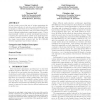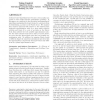55 search results - page 1 / 11 » Tight Bounds for the Approximation Ratio of the Hypervolume ... |
PPSN
2010
Springer
13 years 3 months ago
2010
Springer
The hypervolume indicator is widely used to guide the search and to evaluate the performance of evolutionary multi-objective optimization algorithms. It measures the volume of the ...
GECCO
2010
Springer
13 years 9 months ago
2010
Springer
In order to allow a comparison of (otherwise incomparable) sets, many evolutionary multiobjective optimizers use indicator functions to guide the search and to evaluate the perfor...
FOGA
2011
12 years 8 months ago
2011
It was recently proven that sets of points maximizing the hypervolume indicator do not give a good multiplicative approximation of the Pareto front. We introduce a new “logarith...
GECCO
2009
Springer
13 years 11 months ago
2009
Springer
Indicator-based algorithms have become a very popular approach to solve multi-objective optimization problems. In this paper, we contribute to the theoretical understanding of alg...
EMO
2005
Springer
13 years 10 months ago
2005
Springer
Abstract. The hypervolume measure is one of the most frequently applied measures for comparing the results of evolutionary multiobjective optimization algorithms (EMOA). The idea t...


